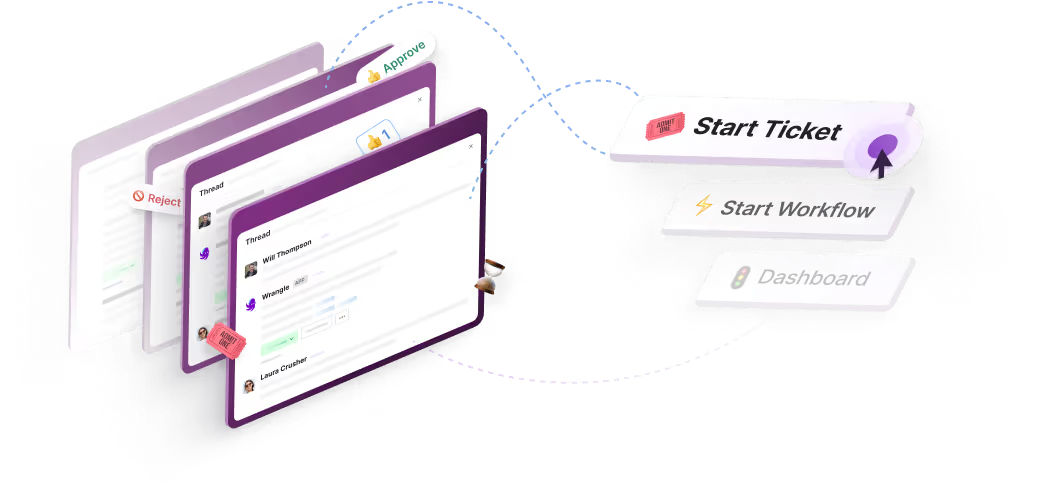Business Process Reengineering (BPR): Definition, Steps, and Examples
Business process reengineering is redesigning a process to better hit your goals.


Here's a quick story about business process reengineering:
In 1940 in San Bernadino, California, two brothers founded a small burger stand to compete with White Castle, the market juggernaut. For eight years they toiled to secure their place in California's burger industry, an emerging market driven by the millions of newly created families during the post-war baby boom and by the arrival of affordable automobiles and interstate highways.

In 1948, the brothers asked their small team to meet them at a local tennis court on a Saturday morning. They began to draw out a new layout for the kitchen in chalk on the court as their puzzled team looked on. All day they drilled their team on this new layout, which had fundamentally rethought how burgers, fries, and shakes could be cooked, packaged, and served in record time. They called it the "Speedee Service System" and mandated that burgers had to come out 30 seconds after a customer ordered.
This idea of rethinking a core workflow is now called Business Process Reengineering. And that little burger stand is now called McDonald's. Business Process Reengineering works for any size company, from a small restaurant to a global conglomerate.
What is Business Process Reengineering (BPR)?
Business process reengineering (BPR) is the act of redesigning a process to improve its ability to achieve business goals. Business process reengineering involves breaking a workflow down to its fundamental steps, thinking critically about how it could be improved, and then launching a new iteration of it to increase profitability and speed. At its core, BPR is about process improvement.
Business process reengineering was something of a call-to-arms in 1990s management culture, emphasizing the transformative power of rethinking the necessity and efficiency of each step in a process, versus resorting to simple outsourcing or automation.
Since then, adjacent concepts have developed to formalize this foundational concept. For example, Lean/Six Sigma is a well-established school of thought which uses the lessons of Japanese manufacturing excellence to reengineer business processes.
How You Reengineer a Process
1. Get stakeholder buy-in
The first step in a business process reengineering is to identify any stakeholders across the organization. It's critical that anyone who touches the process, even tangentially, is brought into the project. Otherwise, you will be focused too narrowly and you'll only achieve marginal benefits to a sub-set of the process. By taking a holistic view, you often realize that entire steps are completely unnecessary. Or, that if certain things happened earlier, you can speed up a different team that is involved later in the workflow.
2. Set audacious goals for the process
Next, you need to establish how you'll measure success. The metrics need to be tied to a tangible business outcome: more revenue, less cost, or more speed. All the stakeholders need to agree on the goals, so that you can take a critical look at every step in the workflow to determine whether it is achieving or failing at the goal.
At this stage, you're looking for goals for the whole process, not for individual teams that take part. Otherwise, you'll see teams improve their performance, but it may actually come at the expense of other teams — for example, they may cut out parts of the flow that they think are unnecessary, but are critical to later teams in the flow.
3. Inventory and document the current process
If you find yourself reengineering a business process, it's often the case that no one in the company has taken a holistic look at how the process works in years. Documentation may be missing or outdated. Some of it may be tracked in one department's software systems, and the rest in spreadsheets or other department's systems.
This is a critical problem to overcome. The team leading the business process reengineering project must first meticulously document every step in the workflow from beginning to end, across all teams that are involved. Otherwise, they don't have the foundational knowledge to decide how to rearchitect the workflow.
4. Identify the inefficiencies in the workflow
With a comprehensive diagram or document outlining the current process, the team can now analyze where there are problems. We'll discuss the kinds of problems to look for a bit later, but they could be things like: bottlenecks and slowdowns in the process, unnecessary steps, or manual effort that could be digitized and automated.
Resolving these these inefficiencies is how we will hit our business process reengineering goals.
5. Design solutions to workflow problems
This is where the real art is in process improvement: figuring out how to fix the problems you've now documented and identified. Entire business school curricula are filled with case studies on different approaches, and schools of thought like Lean/Six Sigma excel here.
The key is to look both locally, at one part of the workflow, and globally, at the whole flow. That way, you can decide whether a fundamental re-architecture of the flow is necessary, or whether we can just optimize the one step.
6. Implement the new process
Once you have a plan in place for how to reengineer the process, the next step is to document the new workflow and to train the team on it. Make sure to start with the overall goals of the reengineering effort, so the wider team gets context on what they're trying to achieve. Likewise, share what you found in documenting the existing process, so that the (perhaps radical) changes you're introducing won't be as surprising as they might seem.
7. Track and analyze results
It's critical that you document, track, and analyze the performance of your new process. A business process management tool like Wrangle can be instrumental here, because it automates all of this work.
Just like you did with the old process, apply your detective skills to the new process to see if you're meeting your goals and to see where you might further improve the process in future iterations.
8. Iterate
Each time you reengineer your process, you're making an educated guess about what will drive results. Whether or not they succeed, there is always more progress that can be made. Because of this, business process reengineering really should be a recurring project (practicing what Six Sigma calls continuous improvement).
You can repeat these steps as many times as you need to so that the process continues to improve.
Process problems you can fix with Business Process Reengineering
Complex workflows inevitably develop all sorts of communication breakdowns, inefficiencies, bottlenecks, and drudgery. With business process reengineering, we can identify problems like these. Here are the kinds of things you should be looking for when analyzing your own processes:
- Do we need this step? Once you've mapped out your process, it often becomes clear that you're doing something that you could get away with not doing. For example, maybe the VP of the department doesn't need to personally approve every bit of spending unless the request is to spend a very high amount.
- Can we parallelize this work? The other thing you'll realize is that certain groups may be waiting on other teams to complete their tasks, unnecessarily. You often realize that you need to reengineer the workflow so that both teams can get started earlier, in parallel, on the bits of the process that aren't dependent on each other.
- What could we do early to help later steps? You may find that a lot of unnecessary delay or tedium is caused by early groups not realizing they are impacting later groups. For example, it's common for one group to kick off a workflow by making a request for help from another group. But, their requests are often missing data that the later group really needs to be able to execute on the request. By using something as simple as a structured form, you could make sure the later group doesn't waste time replying to ask for more information.
- Can we redo how a step is done to speed it up? Along the workflow, there will inevitably be bottlenecks. Maybe a team needs to digitize a paper step, or hire more people to work on it, or retrain the staff working on it. Finding these small improvements can pay dividends when applied across each step in the process.
- Can we break the process down into smaller processes? Workflows, to quote the movie Shrek, are like onions — they have lots of layers. The more you drill down into one step with one team, you may find that the step actually has its own mini process to complete. Applying business process reengineering to each sub-process may well drive measurable results at the macro level.
- Are we looking too granularly? The inverse can also be true — we're looking at a sub-process of a much larger process, and we need to consider the wider context in order to find ways to improve.
- Have we automated manual work? All along a workflow, there are tasks, approvals, and communications between teams. Each of these things should be digitized and tracked in BPM software like Wrangle so that no one is manually making sure the process is moving along, without having to manually email the next person in the chain to start their work.
How business process management (BPM) can help with business process reengineering
If business process reengineering sounds like a lot of work — it is. But there is software that can make it much easier: Wrangle BPM software.
You can use Wrangle to map and document your process's steps. It's like a digital whiteboard that everyone can see.
Wrangle then automates the process, automatically notifying people when it's their turn. Wrangle even has built-in approvals, task checklists, and a form builder, so that you can digitize the manual steps in the process.
Finally, Wrangle is tracking everything, so you get comprehensive analytics on how your process is doing and where it's breaking down.

- Try Wrangle free for 14 days
- Turn messages into trackable tickets
- Build a scalable help desk



Turn Slack into a productivity powerhouse with Wrangle
Create a scalable helpdesk in Slack. Automatically turn messages into trackable tickets and provide faster, more transparent service to your colleagues and customers with Wrangle — Try it free!






